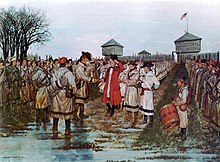
Olivet College, Michigan’s first coeducational college and the first college to admit blacks, was established on this day in February 24, 1844.
The college — named for Jerusalem’s Mount of Olives — didn’t get a charter in 1845, likely because of its abolitionist views, but it ultimately received one in 1859.
The school was founded by the Rev. John J. Shipherd, a Congregational minister, who had cofounded Oberlin College in Ohio in 1833 and came to Michigan with 39 missionaries. The institution bought 40 acres for $100, and the first classes were held in a log cabin that December.

Olivet College Today
Sources :
Historical Society of Michigan and Michigan Every Day.
Zlati Meyer, “Michigan’s 1st coed college, Olivet, founded in 1844”, Detroit Free Press, February 22, 2015.
On February 24, 1928, the use of marijuana was outlawed in Detroit. Interestingly, no state or federal restrictions were on the books at that time.
In 2012 the Detroit City Government is attempting to keep a ballot proposal to legalize small amounts of marijuana for Detroit residents off the ballot.
Statewide, Marijuana advocates are collecting signatures for a ballot to legalize marijuana in Michigan.
Sonny Eliot, the legendary Detroit weatherman whose career in
television and radio spanned over 60 years was a Prisoner of War during World War II. Eliot enlisted after Pearl Harbor and became a B-24 bomber pilot assigned to the 8th Air Force, 577th Squadron, based in Norwich, England. On February 24, 1943 Eliot’s B-24 was shot down during a bombing raid of Berlin. Landing in a field Eliot was quickly captured and was ultimately interred at Stalagluft 1, in Barth, Germany, where he was for the remainder of the war.
Source : Michigan Heroes Museum, Frankenmuth, MI

Automotive designer Roy Brown Jr., who died on Feb. 24 at age 96 in Ann Arbor, Mich., had a long and mostly successful career for Ford, but he’s best remembered for one spectacular miscalculation. The Ford Edsel, which lasted just three model years — 1958, 1959 and 1960 — was a moderately priced status car, aimed at upwardly mobile young families who weren’t yet ready for a Lincoln Continental. Instead, it became one of the most infamous automotive flops ever, earning a spot on Time magazine’s list of the “50 Worst Cars of All Time”.

Here are 10 facts about Brown and his ill-starred creation:
-
- The Edsel cost $250 million to develop, the equivalent of slightly more than $2 billion in today’s dollars.
- Ford set out to develop what public-relations executive C. Gayle Warnock described as “some kind of a dream car – like nothing they’d ever seen.” To that end, the designers included numerous distinctive features that set it apart from other late-1950s American cars. The most obvious was the unorthodox vertical oval front grille, inspired by European limousines, but the car also incorporated technological advances such as a push-button transmission control on the steering wheel and a “unique warning light system” that would alert drivers when they were low on oil or gasoline.
- When the car was under development, an advertising agency came up with a list of 18,000 possible names, but the company also turned to poet Marianne Moore. According to Bill Bryson’s book Made in America, Moore’s suggestions included Mongoose Civique, Utopian Turtletop, Resilient Bullet and Pluma Piluma. Eventually a Ford executive, Ernest Breech, decided to name the car after Henry Ford’s late son, Edsel. That dismayed the researchers, who had tested that name already and found that 40 percent of consumers responded with “What?” when they heard it. “It fails somewhat of the resonance, gaiety and zest we are seeking,” another Ford executive admitted at the time, according to historian David Lanier Lewis.
- To promote the car, Ford sponsored an October 1957 TV special, The Edsel Show, which starred Bing Crosby, Frank Sinatra, Louis Armstrong, the Four Preps and Rosemary Clooney. It attracted 50 million viewers.
- After the Edsel sold poorly in its first three months of release, in December 1957 Ford offered eight-inch plastic souvenir models of the Edsel if they would stop by the dealership for a test drive.
- Brown also supervised the design work on the 1955 Ford Futura concept car, which later was acquired and transformed by George Barris into the Batmobile. Brown later designed British Ford’s successful Cortina.
- Five of the Edsel’s seven model names later were repurposed for other cars, including two built by competitors: the Chevrolet Citation and the AMC Pacer.
- Philosophy professor (and later U.S. Senator) S.I. Hayakawa wrote a 1958 essay (quoted here) in which he denounced the Edsel, criticizing what he called Ford’s “efforts to turn out a car that would satisfy customers’ sexual fantasies and the like.”
- In a 1985 interview with the Fort Lauderdale Sun-Sentinel, Brown attributed the Edsel’s failure not to his design, but to Ford’s mistake in trying to enter a market segment that already had too many competitors. The similarly priced DeSoto, he noted, was discontinued in 1958, the year after the Edsel’s debut.
- For years, Brown continued to drive an Edsel convertible when he was in Michigan. He recalled in the Sun-Sentinel interview that people often stopped him in the Edsel and offered to buy it. To which the Edsel’s chief designer said that he usually replied, “Where the hell were you in 1958?”

Source : Patrick Kiger , “Roy Brown Jr.: He Was ‘Mr. Edsel’”, AARP Blog, March 6, 2013.

The British flag would not be raised above Fort Sackville on the morning of February 25, 1779. British Lieutenant-Governor Henry Hamilton and his garrison marched out of the fort at 10 a.m. and surrendered to American Colonel George Rogers Clark.

As a result of Clark’s brilliant military activities, the British ceded to the United States a vast area of land west of the Appalachian Mountains. That territory now includes the states of Ohio, Indiana, Illinois, Michigan, Wisconsin and the eastern portion of Minnesota.
Sources :

On February 25, 1861, Albion College was authorized by the state legislature to confer 4-year degrees on men and women. The school began as an outpost that offered education to the children of early Michigan settlers and Indians. It was also one of the first schools in the Midwest to offer coed education.
Thanks to the efforts of Methodists who were early settlers of Michigan Territory, the College was awarded a charter by the Michigan Territorial Legislature in 1835. Early attempts at coeducation were made in 1850 when the legislature approved the founding of the “Albion Female Collegiate Institute.” This school for women was controlled by the Wesleyan Seminary corporation until 1857 when the two schools merged under the name of “The Wesleyan Seminary and Female College at Albion.”
On February 25, 1861, Albion was fully authorized by the State legislature to confer a full four-year college degree upon both men and women.
From the time the cornerstone was laid for the first permanent building in 1840 until today, Albion College has remained on the same site, the original part of which is now affectionately called “the Quad.” In 1861 there were only two classroom buildings. By 1901, Albion had added a chapel, an observatory, a gymnasium, a chemistry building and a library.
Today Albion stands on 225 acres with more than 30 major buildings, and from 500 students in 1901, enrollment has grown to 1,710 students. Full-time faculty today number 126, and the College has over 23,000 living alumni.
Emphasis on excellence in liberal arts education became the Albion College hallmark through the years, and in 1940 Albion was the first private college in Michigan to be awarded a chapter of Phi Beta Kappa. Today the College remains true to its liberal arts commitment.
The campus itself has also changed dramatically in recent years. Since 1975, Albion has built the Herrick Center for Speech and Theatre, Sprankle-Sprandel Stadium, the Whitehouse Interpretive Center, Dean Aquatic Center, Mudd Learning Center, Olin Hall, Dow Recreation and Wellness Center, Kellogg Center, the Mae Harrison Karro Residential Village, the Ferguson Student, Technology, and Administrative Services Building and Kresge Hall. In addition, many older campus buildings have been thoroughly renovated.
Sources :
Michigan Every Day.
Albion’s History, courtesy of Albion College.

Hotels and restaurants along the Straits of Mackinac have seen an infusion of cold cash.
“My tips have gone from $30 or $50 a day to $200 or $300,” said Megan MacLeod, a waitress at the Dixie Saloon in Mackinaw City. “I had a table from Georgia, another from Minnesota. People are coming from everywhere. It’s fantastic.”
With crowds pouring into the tiny community, a popular summertime stop for families headed to Mackinac Island or the Upper Peninsula, a usually quiet winter season has transformed the place.
“Tourism has been crazy,” said Rick Caldwell, front desk manager at Hamilton Inn Select Beachfront. “We even had to open other hotels. People have come from as far as Kentucky, Indiana and Ohio.”
Most of the visitors saw images of the rare and uniquely beautiful blue ice posted on social media and have gone to check it out for themselves.
“We haven’t had blue ice in about seven years,” Caldwell said. “And this was even better than last time.”
For the full article, see Phoebe Wall Howard, “Blue ice brings summer-like tourism boost to Mackinaw City“, MLive, March 16, 2018.
Tanda Gmiter, “Blue ice piling up near Michigan’s Mackinac Bridge“, MLive, February 26, 2018.
Hilary Brueck, “Rare blue ice usually only seen in the Arctic has come to US shores — and photographers are capturing stunning images“, Business Insider, March 2, 2018.

On February 26, 1800, Lucius Lyon was born in Vermont. Lyon was the first elected U.S. senator to represent Michigan, but he had to be a non-voting member at first until Michigan became a state in 1837.
Lyon had submitted a petition for statehood in 1833, but a border dispute with Ohio over Toledo delayed the process.
Municipalities like South Lyon, Lyon Township in both Oakland County and Roscommon County and Lyons Township are all named after him.
Sources:
Michigan Every Day
Lucius Lyon wikipedia entry
On February 26, 1809, the Michigan territorial Gov. William Hull and the three judges of the Michigan Territory framed “an act concerning schools,” which allowed for the creation of local taxes of $2 to $4 per school child to support the territory’s poorer schools.
The session was held on a Sunday and was likely held in Richard Smyth’s tavern on Woodward Avenue near Woodbridge Street.
Source: History of Higher Education In Michigan; History of Detroit and Michigan
During the 1830s and 1840s, Burt and his crew surveyed much of Michigan. According to the U.S. surveyor general, Burt produced “the most satisfactory” work he had ever seen. Burt also invented the solar compass to work in areas where minerals in the ground might make the needles of their magnetic compasses act wildly and produce errors. Burt’s solar compass saved the U.S. government lots of money when the country’s western territories were surveyed.
Burt lived in Michigan from 1822 to 1858.
Source : Michigan Historical Calendar, courtesy of the Clarke Historical Library at Central Michigan University.
For more information, see Wikipedia
